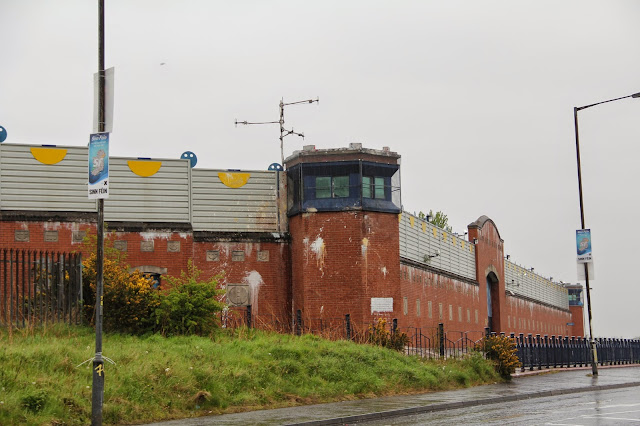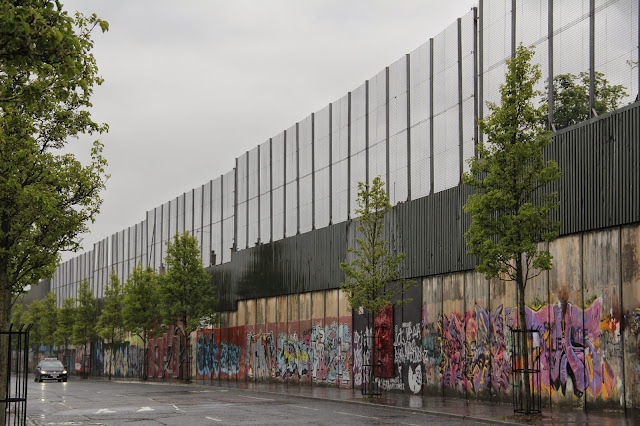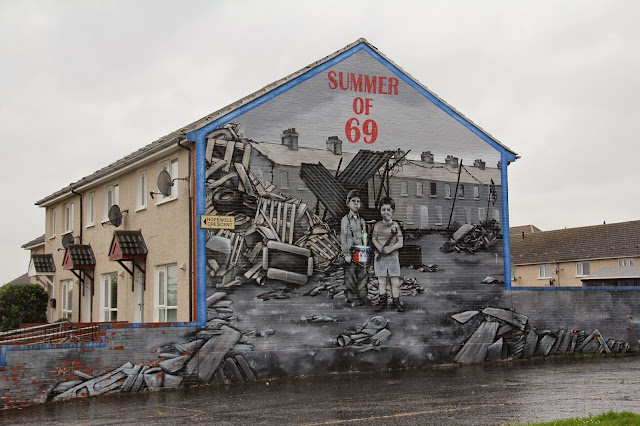Day one. North Ireland. We arrived in Belfast (above) at about 2:00 after a 2 1/2 hour ferry ride from Scotland. We checked in at the Pearl Guest House--an apartment of four bedrooms, bath, living room, kitchen (we bought cold cereal and milk for our breakfast) and washing machine (beats using a hotel bathroom sink). We then called Belfast Black Cabs Tours +44 (0) 7842 697 314 to arrange a tour of the murals of a divided Catholic/Protestant Belfast. Our delightful, informative, fast talking guide and driver Brian (a Catholic, but other drivers are Protestant--each giving his own bent to the narrative) showed up at our door step 15 minutes later and took us on a rainy 2 1/2 hour tour of the Catholic neighborhood along Falls street and then the Protestant neighborhood along Shankill Road. They are divided by an imposing wall with gates that close during the night. The wall does not extend forever so there are ways to get around it. It is thus nothing more than an inconvenience to keep the two opponents from interacting much or fighting each other. Things are certainly much better now in North Ireland now that it has more autonomy, its own parliament, and greater rights and opportunities for the Catholics, but his tour showed that there is still a long way to go. Like South Africa--on paper things look good, but in reality apartheid and the old divided/hostile IRA days of north Ireland still linger in many ways.
Hunger strikers.

North Ireland Catholics sympathize with many other disenfranchised minority groups and individuals.
Bobby Sands who died from his hunger strike.
A lark breaking the chains of political oppression.
The Catholic monastery where the Good Friday agreement was hammered out which gave Catholics greater rights and brought relative peace to North Ireland.
The ruling English named city streets after colonial holdings around the world--salt on the wound.
Catholic homes burned by Protestants back in the 1969.
New homes were built for the displaced families. Notice the Palestinian flag.
Memorial to those from this neighborhood who lost their lives during "the troubles."
The gate in the wall dividing the two neighborhoods is opened once a year so Protestants can march/parade through the Catholic neighborhood. Provocative marches like this are often a sure recipe for conflict.
From a Catholic perspective, even the Irish Potato famine was the fault of the British.
The outer wall of a highly fortified British prison where Catholics were detained.
The open gate. It closes from 10 pm to 6 am.

The Protestant side. They are descendants of Sottish and English Protestants who settled in Ireland hundreds of years ago. They want to remain a part of the UK while the Catholics want to be part of the Republic of Ireland. Once the Protestants made up 70% of the six counties of Ulster. Now they are down to 47% with the Catholics at about 44%.
The place of annual bon-fires
The wall with Protestant grafitti.
A gate. Seldom used and last used by the Dalai Lama.
For Protestants divided walls (in Israel/Palestine, Belfast, Baghdad, and Berlin) are an acceptable way to keep the peace.
Honoring Protestant fighters.
Highlighting Catholic acts of violence.
Memorializing those killed in "the troubles."
Shankill Road. I first learned about this road and this highly segregated city when I was in graduate school and I was studying segregated cities in preparation for my study on the religious quarters of Nazareth.
Honoring those who kill in the name of nationalism.
This known killer has you in his sight--no matter what the angle.
New homes built where Protestant homes were burned.
Thanks Brain for a great tour. My students will love these images and all the information you shared.
It rained on our mural tour, but next morning brought sunshine.
Pearl Guest House
Emerald hills of North Ireland.
When we crossed into the Republic of Ireland there was no welcome to Ireland sign. Just a notice that we were entering a new county. I wondered if Ireland offered no welcome because in its view there should be no border.

The River Boyne. Its valley is home to some impressive neolithic sites called collectively Bru ua Boinne.
Knowth, a large human built burial mound with inner corridor and surrounding smaller mounds.

Entry way and fertility rock--very smooth on the inward side which indicates that early visitors to this site all ran their hands along this now much smoother side,
Impressive geometrically decorated foundation stones.

Newgrange. The white face of stone is aligned to reflect the winter solstice sun and its inner corridor is aligned so that on the winter solstice the rays of the sun penetrate all the way into the intersect of its cross like corridor.
The sun's rays enter through the top window.

We got to Dublin early enough to track down the place where Marie was born--Fitzwillliam Square 36. Dublin was her dad's first foreign service post. At the time most babies in Ireland were born at home, but Marie's mom wanted nursing care so she arranged to give birth in an old-folks home.
Marie spending the day before mother's day visiting where her mother gave birth to her.
The US embassy in Dublin.
We then tried to track down the house where the Tueller family lived. We got to the Simmonscourt neighborhood--where we found Simmonscourt Road, Avenue and Square, but not Bungalow (which is what is listed on the birth certificate).

Some of the streets are now gated communities.
We took a photo of this church for Marie's parents to use as a landmark to verify or not whether we were in the right area.
We started out our Sabbath with a much needed sleep in. All four wards listed for Dublin started at 11:00. We chose the closet one. Marie has not always been a big fan of Mother's Day sacrament meetings in the USA so it was a refreshing change to spend the second Sunday in May with talks about the atonement.We then headed out to see some highlights of Dublin. First stop was Trinity College.
The long room of the library.
Facsimiles of the Book of Kells. Hand written, beautifully illustrated Bible from 800 AD.
Sphere within a sphere. Inner globe is the world, outer globe is Christianity.
Cricket practice
Where to go next? Suggestions? Does anyone have the energy or interest to go further?
Yes they do. Next stop the National Museum of Ireland--Archaeology to see a beautifully carved mace head (about three inches long) discovered at Knowth.
Every street in Dublin was flooded with posters for and against an upcoming referendum on marriage.

Next stop was the Museum of Natural History. Here's how it was described by Lonely Planet: "Dusty, weird and utterly compelling, this window into Victorian times had barely changed since Scottish explorer Dr. David Livingstone opened it in 1857." They got that one right. The ground floor was not impressive enough to compel three in our party to go higher, so Will and his dad went forth on their own to enjoy display case after display case of some very old, but certainly compelling animals. The stuffed orangutan dated back to the 1890s!
We then walked to Christ Church for its 5:00 evensong (as noted in Lonely Planet) only to find our that it is now held on Sundays at 3:00. Rats.
We were able to slip inside and enjoy the the first part of the Dublin Chamber Orchestra's rehearsal for a concert later in the evening.
 We enjoyed good Arab food for dinner (a meal we can always agree on) and then walked around Dublin Castle. One Norman tower from 1258 remains.
We enjoyed good Arab food for dinner (a meal we can always agree on) and then walked around Dublin Castle. One Norman tower from 1258 remains. 
Bedford Tower flanked by gates topped with statues for justice (right) and fortitude (left). Built in 1750 when Ireland was still a British Colony, this was one last reminder of how the British viewed their presence in places far and near.
Justice
Fortitude
















































































No comments:
Post a Comment